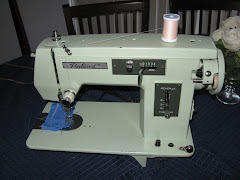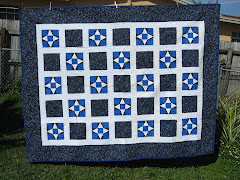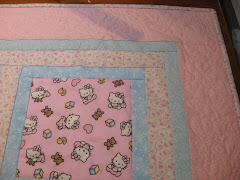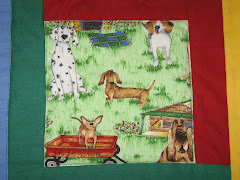Saturday, January 30, 2010
My other hobby
My husband and I collect and restore old vintage sewing machines. Sometimes they are old, dirty looking machines that no one (is that in their right mind) would want. I have an appreciation for older things. That could be connected to the realization that I was born in the day of black and white television and pre computer age. These old sewing machines were always made of cast iron and extremely heavy. They don't have the nice features of the newer computerized sewing machines, but they never quit on you. They also sew through multiple layers of fabric quite easily. I recently read a quilters comment that the sewing area is also larger for handling larger quilts. That's called the harp area of the sewing machine.
Anyway, I just had to "proudly" put a pic of one of our new additions to our collection of vintage sewing machines. This one we will sell on craigslist.
It's an Arrow sewing machine, a Singer model 15 clone, straight stitch machine. I really liked the turqoise and chrome colors on the machine.
Thursday, January 21, 2010
Quilt batting matters
Quilt batting for non quilters is the material sandwhiched between the top and back of your quilt. My great grandmother had to "card" cotton and clean it to use it in a quilt. It was painful on the fingers, time consuming, and produced a lumpy but warm quilt. Fast forward to the creation of polyester. Quilts were often made with polyester batting when polyester batting was first introduced on the market. I used polyester batting in the quilts I made in the 70's and 80's.
Initially they were beautiful quilts. However, over time they were not so beautiful after some wear and age.The older polyester was a harder and not so soft polyester. It contributed a nice appearance to a finished quilt but the polyester starts to "strand" through the cotton fabric and the once beautiful quilt now looks like it's shedding from the inside out. Pieces of polyester fiber work their way through the fabric to the surface of the quilt. After this experience I never used polyester batting again. I recently came across some information that polyester batting has greatly improved since I last used it.
While reading one of my quilt reference books I found a rating list of battings which included polyester, cotton, wool, and silk battings.
The ratings were for warmth, shrinkage, longevity, quilting ease, and price.
I wasn't surprised by the longefity of cotton quilts vs. polyester, but I was surprised that polyester has been improved up. The new polyester batting is
"supposed" to be finer, softer, and easier to work with than the polyester batting of the past. I say "supposed" because I have not recently used a polyester batting. I plan to make a lap quilt that I will not have a lot of time invested in and use one of the new and improved polyester battings. I will post the results of my findings in a few months.
Initially they were beautiful quilts. However, over time they were not so beautiful after some wear and age.The older polyester was a harder and not so soft polyester. It contributed a nice appearance to a finished quilt but the polyester starts to "strand" through the cotton fabric and the once beautiful quilt now looks like it's shedding from the inside out. Pieces of polyester fiber work their way through the fabric to the surface of the quilt. After this experience I never used polyester batting again. I recently came across some information that polyester batting has greatly improved since I last used it.
While reading one of my quilt reference books I found a rating list of battings which included polyester, cotton, wool, and silk battings.
The ratings were for warmth, shrinkage, longevity, quilting ease, and price.
I wasn't surprised by the longefity of cotton quilts vs. polyester, but I was surprised that polyester has been improved up. The new polyester batting is
"supposed" to be finer, softer, and easier to work with than the polyester batting of the past. I say "supposed" because I have not recently used a polyester batting. I plan to make a lap quilt that I will not have a lot of time invested in and use one of the new and improved polyester battings. I will post the results of my findings in a few months.
Saturday, January 16, 2010
Organized Sewing
I recently viewed a message board for quilters. This is January, the month that seems to be the universal month for organzing everything, including the space you use to sew or quilt. I began cleaning off my cutting table at the beginning of the month. This also was the beginning of a fabric sale for 50% off already reduced fabric. The once clean organized space is now covered..once again with fabric. Beware, quilting is definitely fabric addictive.
Other quilters posted their before photos of their sewing areas. I am laughing. Not at the mess of others, but my inhibition of not posting photos of my mess. The age I grew up in shamed us for messiness. It attached a stigma to your personal value if you were a "messy". That hopefully is a dead value system by now, and if not, it should be.
I guess the shadow of the shame of being messy still lurks somewhere. Otherwise, why would I even look at an organized sewing room. Actually, the ones who were sewing and making quilts were the messy ones. I did not see any sewing or quilts in progress in the beauitfully organized sewing rooms.
I will say, I enjoyed seeing what an organized sewing space is supposed to look like. My advice would be as much as possible, have a place for everything and everything in its place. Donate or throw out what you don't use. After you use "it", put it back in the place it came from. This works for me but for one exception...the 50% off fabric sale and where to put more fabric.
Other quilters posted their before photos of their sewing areas. I am laughing. Not at the mess of others, but my inhibition of not posting photos of my mess. The age I grew up in shamed us for messiness. It attached a stigma to your personal value if you were a "messy". That hopefully is a dead value system by now, and if not, it should be.
I guess the shadow of the shame of being messy still lurks somewhere. Otherwise, why would I even look at an organized sewing room. Actually, the ones who were sewing and making quilts were the messy ones. I did not see any sewing or quilts in progress in the beauitfully organized sewing rooms.
I will say, I enjoyed seeing what an organized sewing space is supposed to look like. My advice would be as much as possible, have a place for everything and everything in its place. Donate or throw out what you don't use. After you use "it", put it back in the place it came from. This works for me but for one exception...the 50% off fabric sale and where to put more fabric.
Thursday, January 14, 2010
January in pink
I'm working on two pink baby quilts for a friend's daughter who is having twin baby girls.
Sewing is not something I hurry through. The babies are due in February and I began the quilts in December. I kept the design simple and limited the quilting detail to the border areas. I had personal doubts that I would finish these quilts before the babies were born but planned my sewing time a bit better than I normally do and finished with a month to spare! I hope the new mother and babies will enjoy these quilts as much as I enjoyed making them.
Quilting is a process. Through the process you always learn something new that you didn't know when you finished the previous quilt. While making one of my quilts I discovered my sewing machine had a feature that made free motion quilting much easier and the results were much improved. How could I have not read the sewing machine manual and used that feature five quilts ago? Simply because I like to sew now and read later.
Our printer recently broke and it had to be replaced. I envisioned plugging that printer in and Wola! I would be ready to print, scan, and email with a new printer.
Hours later after reading the instructions numerous times, I finally called the tech for the printer manufacturer. (I also read the manual before installing, so the read first doesn't always prove to be success at first try. After an hour with the tech on the phone we were successful in installing a new printer.
I am now learning to set up and write a blog. I saw some instructions in the log in page and I definitely need to read it before I go any further with this blog.
Sewing is not something I hurry through. The babies are due in February and I began the quilts in December. I kept the design simple and limited the quilting detail to the border areas. I had personal doubts that I would finish these quilts before the babies were born but planned my sewing time a bit better than I normally do and finished with a month to spare! I hope the new mother and babies will enjoy these quilts as much as I enjoyed making them.
Quilting is a process. Through the process you always learn something new that you didn't know when you finished the previous quilt. While making one of my quilts I discovered my sewing machine had a feature that made free motion quilting much easier and the results were much improved. How could I have not read the sewing machine manual and used that feature five quilts ago? Simply because I like to sew now and read later.
Our printer recently broke and it had to be replaced. I envisioned plugging that printer in and Wola! I would be ready to print, scan, and email with a new printer.
Hours later after reading the instructions numerous times, I finally called the tech for the printer manufacturer. (I also read the manual before installing, so the read first doesn't always prove to be success at first try. After an hour with the tech on the phone we were successful in installing a new printer.
I am now learning to set up and write a blog. I saw some instructions in the log in page and I definitely need to read it before I go any further with this blog.
Subscribe to:
Posts (Atom)






